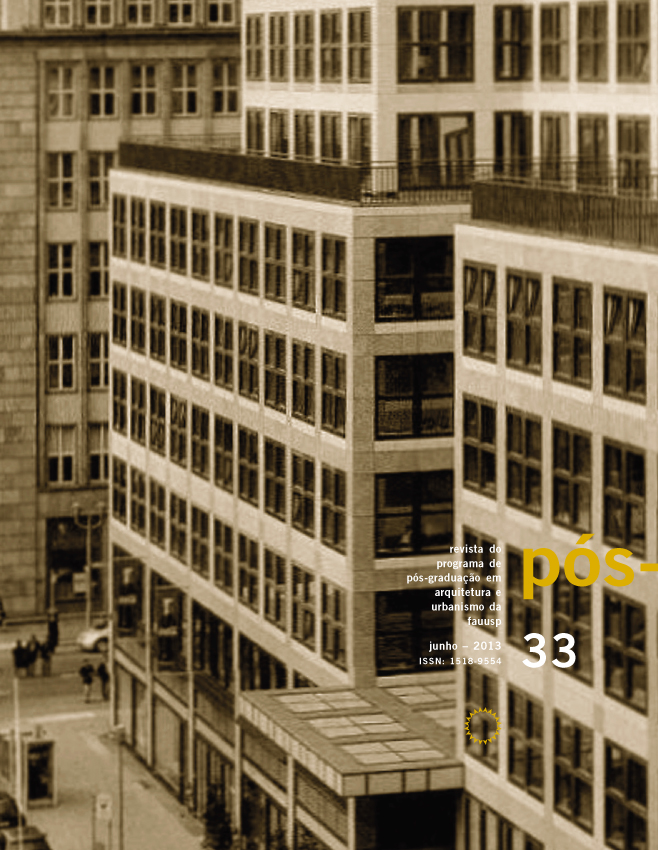Diagram, architecture, and autonomy
DOI:
https://doi.org/10.11606/issn.2317-2762.v20i33p160-180Keywords:
Peter Eisenman. Architecture. Autonomy. Diagram. Diagrammatic. Process.Abstract
To what extent can design practice inform a new aesthetic agenda in architecture? Does the rationality inherent to the design process trigger the emergence of symbolic content? If architecture is an autonomous disciplinary field, to what realm does this autonomy belong - to the built work, to the project, or to the moment of creation? This article discusses the role of the diagrams and the diagrammatic process in Peter Eisenman’s theoretical work. It is argued that, because Eisenman formulates his diagrammatic project on the frontiers of semiotics, phenomenology, cognition, and philosophy, his approach to the diagram represents autonomous aesthetic design architecture. The diagrammatic process, singularized in a strategy of opening up the design process, engenders a disciplinary and political purpose. The terms under which diagram and diagrammatic process carry through this disciplinary agenda are here problematized by the confrontation of his discourse on the diagram with his formal experiments. The assumption is that, with Eisenman, the specificity of the diagram, neither merely confined to the employment of new technologies nor to the structuralist discourse of postmodernist architecture, breaks down the critical and political project of modernity. Although semiology and theoretical appropriation of the iconic diagram have become a reference in postmodern architecture1, deeper understanding of Eisenman’s diagrammatic theoretical project has exposed conceptual shifts in the status of what is usually understood as a diagram, shifts that are now widespread in the technological cutting edge in contemporary architecture. With emphasis on the phenomenology of the diagram, we attempt to understand the aesthetic sense of this reorientation in designing with diagrams by the architect Peter Eisenman. Research into the aesthetic role of the diagram ultimately seeks the relationship between a diagrammatic expression that singles out the modernity of the 20th century and the establishment of a cultural autonomy formulated within the architecture.Downloads
References
ALLEN, Stan. Diagrams matter. ANY: Diagram Work: Data Mechanics for a Topological Age, New York, no 23. p. 16, jun. 1998. EISENMAN, Peter. Duck Soup. LOG 7, New York, p. 16, spring-summer, 2006.
ARGAN, Giulio Carlo. Arte moderna: do iluminismo aos movimentos contemporâneos. São Paulo: Companhia das Letras. 1998. 709 p.
BRENTANO, Franz. Psychology from an Empirical Standpoint. Tradução de Antos C. Rancurello, D. B. Terrell and Linda L. McAlister. London and New York: Routledge, 1995. 415 p.
DELEUZE, Gilles. Lógica da sensação. São Paulo: Zahar, 2007. 506 p.
DERRIDA, Jacques. A estrutura, o signo e o jogo no discurso das ciências humanas. In: A escritura e a diferença. 3ª edição. São Paulo: Perspectiva, 2005. p. 229-249.
EISENMAN, Peter. Arquitetura e o problema da figura retórica. In: Inside out: selected Writings, 1963-1988. New Haven: Yale University Press, 2004. 247 p.
EISENMAN, Peter. Autonomy and the will to the critical. Assemblage, Cambridge, nº 41, p. 90, abr. 2000.
EISENMAN, Peter. Barefoot on white-hot walls. Ostfildern: Hatje Cantz Publishers, 2005. 180 p.
EISENMAN, Peter. Diagram diaries. New York: Universe publishing, 1999. 240 p.
EISENMAN, Peter. Diagram: an original scene of writing. In: Diagram diaries. New York: Universe publishing, 1999.
EISENMAN, Peter. Terragni and the idea of a critical text. In: Written into the void: 1990-2004. New Haven: Yale University Press, 2007. p. 126-132.
FOUCAULT, Michel. O que são as luzes. In: MOTTA, M. (org.). Ditos e escritos II: arqueologia das ciências e história dos sistemas de pensamento. Tradução de Elisa Monteiro. Rio de Janeiro: Forense Universitária, 2005. p. 335-351.
HABERMAS, Jürgen. La modernidade. Un proyecto incompleto (1980). In: La posmodernidad. Tradução de Jordi Fibla. Barcelona: Editorial Kayrós, 1983. p. 19-36.
KNOESPEL, Kenneth J. Diagrammatic transformation of architectural space. Disponível em: http://www.lcc.gatech.edu/~knoespel/Publications/DiagTransofArchSpace.pdf. Acesso em 18 nov. 2011.
LYELL, Charles. Principles of geology. Disponível em Project Gutemberg Ebook, 2010. Ebook 33224 em: http://www.esp.org/books/lyell/principles/facsimile/. Acesso em 20 nov. 2011.
MONEO, Rafael. Inquietação teórica e estratégia projetual na obra de oito arquitetos contemporâneos. Tradução de Flavio Coddou. São Paulo: Cosac Naify, 2009. 368p.
NESBITT, Kate. Uma nova agenda para a arquitetura. São Paulo: Cosac Naify, 2008. 661 p.
SOMOL, Robert. Dummy text, or the diagrammatic basis of contemporary architecture. In: EISENMAN, Peter. Diagram diaries.. London: Universe, 1999.
SYLVESTER, David. Interviews with Francis Bacon. London: Thames and Hudson. 2009. 128 p.
Downloads
Published
Issue
Section
License

This work is licensed under a Creative Commons Attribution 4.0 International License.
DIADORIM - Diretório de Políticas Editoriais












